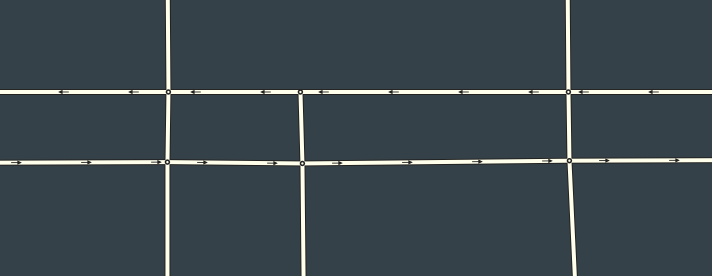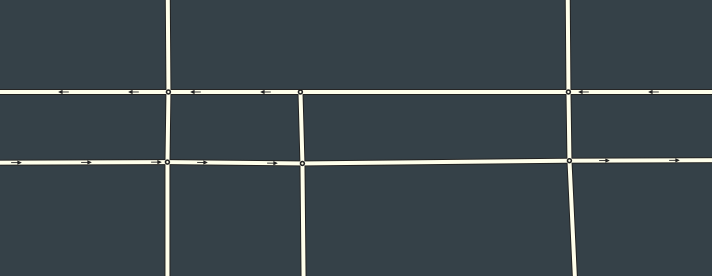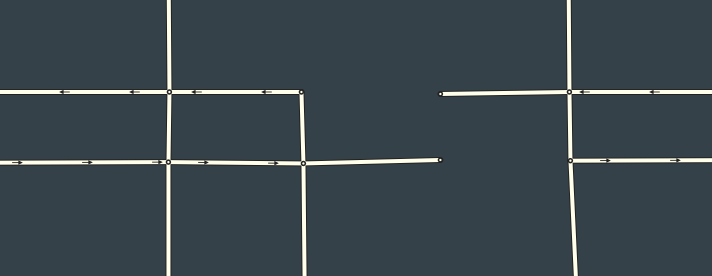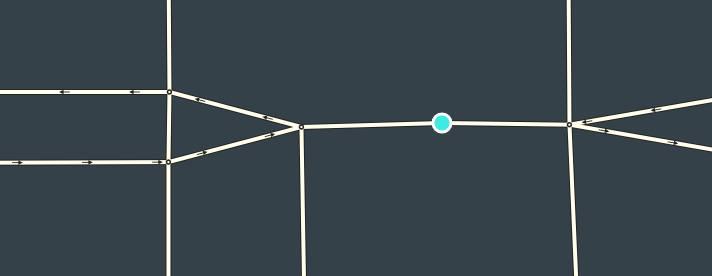Road Naming
Highways
Freeways, minor highways, and major highways should be named in this format:
Nova Scotia, Ontario, Manitoba, Saskatchewan, Alberta, British Columbia, and territories
Hwy # (H is capitalized, the 'wy' in lower case, followed by a number), e.g. Hwy 16. Not "Highway #" or the all-caps "HWY #".
Quebec, Newfoundland and Labrador, New Brunswick, and PEI
Rte # (R is capitalized, the 'te' in lower case, followed by a number), e.g. Rte 99. Not "Route #" or "RTE #".
Autoroute is abbreviated to Aut, e.g. Aut 15.
For ALL of Canada
Where the signage indicates the highway based on a name ("Lougheed Hwy" or "Sooke Rd"), the name should be used. If, however, the signage refers to it by number primarily, that is to be the primary name, regardless of the local knowledge (e.g. the Sea-to-Sky Highway is signed as Hwy 99 and Wheeler Blvd is signed as Rte 15). If a numbered highway has local named signage as above e.g. "Lougheed Hwy" or "Sooke Rd", the highway number must be used as an alternative name.
Big green signs
Segment naming for ramps and wayfinders should follow the big green sign (BGS) text with the following rules.
Segment name should generally follow signage as read, i.e. left to right, top to bottom, except all numbered highways, should be shown first, followed by destination, followed by icons if applicable. All should be separated by a forward slash (“ / “), with a space before and after the slsh. Most BGS layout follows this standard.
Acceptable icons to use are “✈️” for Airport and “⛴️” for Ferry. You must copy and paste these exact icons as these are the only ones that work correctly with text-to-speech. Only use icons if they are used on the BGS, i.e. do not use the icon to replace a spelled out destination such as “Toronto Pearson International Airport” or “Powell River Ferry". You may omit airport and ferry mentions for length considerations.
For more general information on BGS segment naming, please refer to the USA Wazeopedia sections for wayfinders and entry/exit ramps.
Abbreviations
Please follow the Canada Post street-type abbreviation at all times even if it differs from real-life road signs.
Note that while Canada Post does not abbreviate "Place" in French, Waze does abbreviate it as "Pl", just like Canada Post does in English.
Please do not shorten names when they are integral to understanding the street name:
e.g. Bad: N St, S St, Ave Rd e.g. Good: North St, South St, Avenue Rd
It is recommended to use the Custom Canadian WME Validator Script. It will highlight all the incorrectly abbreviated street names.
Street name abbreviations
| Approved Abbreviation | Pronunciation | Do Not Use |
|---|---|---|
| Alley | Alley | Aly |
| Aut | Autoroute | Autoroute |
| Av | Avenue (French) | Avenue, Ave |
| Ave | Avenue (English) | Avenue, Av |
| Bend | Bend | Bnd |
| Blvd | Boulevard | Boulevard |
| Boul | Boulevard (French) | Boulevard, Blvd |
| Brg | Bridge | Bridge |
| Bypass | Bypass | By-pass |
| Carref | Carrefour | Carrefour |
| Ctr | Centre | Centre, Center |
| Ch | Chemin | Chemin |
| Cir | Circle | Circle |
| Circt | Circuit | Circuit, Cct |
| Close | Close | Cl |
| Common | Common | Com, Cmn |
| Conc | Concession | Concession |
| Crnrs | Corners | Corners,Cors |
| Crt | Court | Court, Ct |
| Cove | Cove | Cv |
| Cres | Crescent | Crescent, Cr |
| Crois | Croissant | Croissant, Croiss |
| Crossing | Crossing | Cross, Xing |
| Cds | Cul-de-sac | Cul-de-sac |
| Divers | Diversion | Diversion |
| Dr | Drive | Drive |
| Éch | Échangeur | Échangeur |
| Espl | Esplanade | Esplanade |
| Estate | Estates | Estates, Est |
| Expy | Expressway | Expressway, Expwy |
| Exten | Extension | Extension,Ext |
| Field | Field | Fld |
| Gate | Gate | Gt |
| Gdns | Gardens | Gardens |
| Glen | Glen | Gln |
| Green | Green | Grn |
| Grnds | Grounds | Grounds |
| Grove | Grove | Grv |
| Harbr | Harbour | Harbour, Harbor, Hbr |
| Hts | Heights | Heights |
| Hwy | Highway | Highway |
| Hghlds | Highlands | Highlands |
| Hill | Hill | Hl |
| Hollow | Hollow | Holw |
| Imp | Impasse | Impasse |
| Inlet | Inlet | Inlt |
| Island | Island | Is |
| Knoll | Knoll | Knl |
| Landng | Landing | Landing, Lndg |
| Lane | Lane | Ln |
| Lmts | Limits | Limits |
| Lkout | Lookout | Lookout |
| Manor | Manor | Mnr |
| Meadow | Meadow | Mdw |
| Montée | Montée | Mtée |
| Mount | Mount | Mt |
| Mtn | Mountain | Mountain |
| Orch | Orchard | Orchard |
| Parade | Parade | Pde, Pr |
| Pk | Park | Park |
| Pky | Parkway | Parkway, Pkwy |
| Passage | Passage | Psge, Pass |
| Ptway | Pathway | Pathway |
| Pines | Pines | Pnes |
| Pl | Place | Place |
| Plat | Plateau | Plateau |
| Plaza | Plaza | Plz |
| Pt | Point | Point |
| Port | Port | Prt |
| Pvt | Private | Private |
| Prom | Promenade | Promenade |
| Rg | Range | Rge |
| Ridge | Ridge | Rdge |
| Rd | Road | Road |
| Rdpt | Rond-point | Rond-point |
| Rte | Route | Route |
| Rle | Ruelle | Ruelle |
| Sent | Sentier | Sentier |
| Sq | Square | Square |
| Subdiv | Subdivision | Subdivision |
| St | Street | Street |
| Terr | Terrace | Terrace, Ter, Tce |
| Tsse | Terrasse (French) | Terrasse, Terr |
| Thick | Thicket | Thicket |
| Tline | Townline | Townline |
| Trail | Trail | Tr, Trl |
| Trnabt | Turnabout | Turnabout |
| Villge | Village | Village, Vlg |
Road Types and Functional Classification
Many Canadian provinces and municipalities have a standardized functional classification (FC) system which was adopted by Waze Champs as part of the method for classifying roads in Waze. Overall, this resulted in use of the highway types for arterial roads in urban areas, with the primary-street type being available for collector-type roads.
Unfortunately, Canada does not have standardized government-published maps, but we can implement these principles where local governments publish road classification maps. In general, we can find such maps for any city with a population exceeding ~40,000. We can adopt FC in smaller municipalities, but finding the information will be harder and the benefit less obvious.
Lists of existing conversions to Waze road types may be found on the province-specific wiki pages:
Roads in cities
As a highway enters a city/town, it often becomes a named street, and sometimes would no longer fit the usual criteria for a "highway".
Due to a number of reasons, including long-distance routing issues, as well as appearance, the highway should remain the same type as it is when it enters the city/town.
If a freeway no longer fits the freeway criteria, it may be downgraded to major highway with preferred routing until it again satisfies freeway criteria. One examples of this includes parts of the Trans-Canada Highway that travel through national/provincial parks with frequent stops, reduced speed, and undivided portions. Another example is Autoroute 20, which becomes Boul Harwood in Vaudreuil-Dorion, Quebec.
Freeway (Fwy)
In general, freeways will have:
- multiple lanes of divided roads;
- no cross traffic;
- no stop lights (except for ramp meters) or stop signs;
- no parking;
- no stopping (except for toll booths, freeway-access metering, movable bridges, and traffic congestion);
- minimum speed limits;
- limited access for pedestrians, bicycles, mopeds, and animal-drawn vehicles; and
- entrance and exit ramps.
Use these freeway criteria as a guideline. A freeway may lack one or more features but still be classified as such (e.g. Hwy 16 west of Edmonton doesn't have ramps for every junction, but meets all other criteria).
Major highway (MH)
Use these for major arterial roads. Often, these have two, three, or more lanes in each direction, and may be structured to be turned into freeways eventually. Usually this means relatively few intersections, higher speed limit, and higher capacity.
Additionally, if a road enters an area as a freeway, then loses its limited-access situation, it will generally continue as a major highway.
If a municipality uses only one type of arterial road on its maps, the Waze map editor's decision between setting a MH or mH will rely on relative importance, capacity, and local classification or custom. Generally, a MH will have two or more lanes, whereas a minor may only have one. Local knowledge is especially useful - for example, many 100-level routes in Quebec are one lane in each direction yet are classified as MH.
Minor highway (mH)
Use mH for arterial roads. They are more direct than using collector roads and sometimes have slightly higher speed limits.
Primary street (PS)
Suitable for collector roads through neighbourhoods and thoroughfares that aren't arterial.
Private road (PR)
Private roads (PR) should be used for roads or networks of roads in complexes like military bases, industrial truck access, campgrounds, cemeteries, etc.
Another proper use of private roads is for bus-only roads or drive-through service at restaurants or banks where the only possible destination is to use that service.
Use private roads when converting any standard road that to limit through-traffic to traffic that should reach only a destination on that road (such as for long-term construction that allows only local traffic) yet must retain its speed data. PR segments record and access speed data. Parking-lot roads (PLR) do not.
Use a PLR for all other cases. See the section on Alleys and Laneways below for more information.
Ferry
Only map ferries that can carry standard cars. If the ferry has a toll, mark it as a toll road. You can find more guidance on the US Ferries page.
Narrow street / Passageway
Never use the narrow street or passageway type in North America. This street type designates segments only wide enough for a scooter and will only permit routing for users with the motorcycle type of vehicle selected.
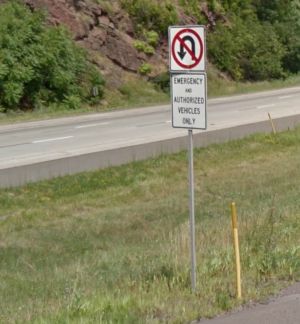
Emergency-vehicle roads
Roads meant for "Emergency and Authorized Vehicles Only" are to be treated as non-drivable roads. These are found primarily through the median of divided highways to connect opposite direction lanes. We recommend not to map them in Canada.
Alleys and Laneways
Alleys and laneways (hereafter referred to simply as alleys) should be added to the map. This is a change in the Waze standard that is going into effect across all of Canada. The proper road type to use for these segments is parking-lot road (PLR), not private road (PR) no matter how much Webs101 whines.
Principles
Allowing unobstructed routing into an alley is appropriate in the following circumstances:
- When no stopping is permitted on the street which the destination faces, and there is access available from the rear. (This does not mean that alleys should be omitted if stopping is allowed on the main road.)
- The alley is used to access carriage / infill homes.
- The alley provides access to exclusive-use parking for venues or homes. (A secondary entry point for certain venues that normally have an entrance accessed from the main road may use the alley.)
- The alley has a street name and has addresses only accessible via the alley.
House numbers do not provide for direct-to-door navigation on PLRs or PRs, so places with entry points (including residential place points) must be used to force routing to destinations on these segments if the destination requires a stop on the PLR.
Editing practices
Alleys should have a city name set and the “None” box checked for street name unless a name is displayed on official signage or can otherwise be verified. Use a PLR even if the street has a name (previously, we would use PRs).
Pay particular attention to turn restrictions and directionality. Use Street View and satellite imagery to look for signage or arrows painted on the ground indicating one-way travel or turn restrictions.
After a tile build, perform spot-testing of navigation to both named destinations as well as addresses to ensure users will not be routed into the alley inappropriately. Add places with entry points on the main road as appropriate to correct undesired routing behaviour.
When adding alleys, pay attention to the potential for inadvertent routing into the segment. Waze’s routing engine will consider contiguous PLR segments - even those linked across nodes at standard road types – to be united as one parking-lot unit. As a result, it may route users into the alley network prematurely if traffic conditions dictate. If route-testing or user reports indicate evidence of this behaviour, "continue straight" turn arrows can be marked as full-time difficult turns or even blocked turns between alleys.
Left turns into or out of alleys at junctions with busy roads may be set as difficult turns fully or during daytime hours to limit impact to traffic flow at editor discretion.
Per standard guidance, alleys with restricted or difficult turns should be locked to L3 or higher to ensure the configuration is preserved.
Some cities have a number of streets that are effectively alleys, but have addresses on them. Continue to use PLRs to map these, and add places to enable routing to these locations. If access is restricted by gates or bollards use the PR road type. Places must also be added to facilitate routing on PRs.
Helpful scripts
WME Place Interface Enhancements (PIE) can greatly speed up the creation of places, particularly RPPs.
WME Place Harmonizer expedites creation of new places by standardizing names, supplying websites for known chains, and parsing phone numbers and hours of operation that editors gather from websites.
WME ClickSaver can streamline creation of PLR and PR segments.
Please see the US Wazeopedia page for scripts if you are unfamiliar with the basics of adding scripts for WME.
Rural Roads
Cottaging, camping, and other backcountry activities are popular pastimes nationwide, and rural resource extraction occurs in every province and territory. As such, major logging, forestry, resource, and other similar backroads should be added to the map.
This is a change in the Waze standard that is going into effect across all of Canada. Waze’s community-built map has the potential to serve destinations that are not covered by most navigation apps and by providing a framework in remote areas for users to be able to build upon, we can grow both our user base and ultimately the editing community.
We see a lot of these roads being added through Project Koifish. It behooves us to understand these rules to further the success of that undertaking.
Editing practices
The proper segment type to use for these segments is more nuanced than other categories of roads because of the way they are treated by the routing engine, but the most common road type to use is off-road/not maintained (OR).
Important: There are two kinds of off-road/not maintained setting. There is the standard OR road type in WME. But there is also a reason for rejection in the Project Koifish interface that lists off-road/not maintained as a reason for rejecting the suggested segment. You can see this in this screen shot:
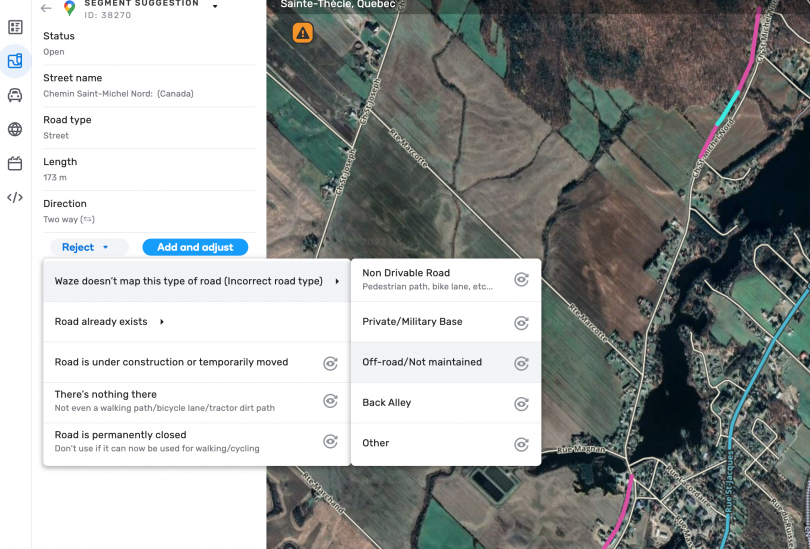
This advice means that we should ignore this reason for rejection. (The same goes for alleys, which, as of this document, the standard is to map.)
Waze will not use a stop point on an OR segment. Destinations along these roads must ultimately be accessed via PLR, PR, or another public road type.
If a road’s existence cannot be confirmed by imagery or another eligible source, do not add it to the map. That does not necessarily mean to reject it. If there is clear indication that a road has been deactivated permanently, delete it. We do not need to add every spur road (although we should if Koifish presents any), but the primary routes should be represented.
Depending on jurisdiction, this category of road is often not part of a city. The "None" box should be selected for city name unless a county or other secondary administrative layer has been implemented in the area. Exceptions can be made on the fringes of towns and cities to enable routing to rural homes and other venues accessed by these roads.
Remote venues such as parks, recreation areas, campsites, and destination lakes/rivers should have the rural road network extended to them to facilitate navigation when possible. Note that this is applies only to logging/forestry/resource roads. Standard practice applies on the standard public or private road networks.
Most jurisdictions have default speed limits which apply when no speed limit signs are posted. These speed limits should be added.
Set the unpaved attribute as appropriate, including on segments using the OR segment type.
Roads known to be maintained and passable year-round may use local street or higher classifications at editor discretion.
Roads in this category that are gated or that are otherwise forbidden for general public use should be mapped as private (PR). Complete mapping in this instance is optional, but short stubs that branch off the main road may provide helpful visual reference for users.
In the event of significant highway closures, route-testing in the area may be prudent in order to confirm that these roads are not recommended to users instead of the next best highway. Additional backcountry closures can prevent undesired routing.
Prairie grid roads
Starting in northeastern British Columbia and extending to the southeast of Manitoba, there is an almost continuous network of grid roads providing access to rural properties, towns, and other destinations. The grid is based on the Dominion Land Survey that was conducted when Canada took possession of Rupert’s Land from the Hudson’s Bay Company. The grid spacing is typically one mile for longitudinal (north-south) roads and one or two miles for latitudinal (east-west) roads with occasional deviation to account for geography. Major highways often coincide with the lines a grid road would otherwise occupy, typically with softened corners to facilitate higher speed travel.
Naming grid roads
Each province has in place its own naming conventions. Longitudinal roads are differentiated from latitudinal roads in the naming scheme.
In British Columbia’s Peace River region, grid roads are simply named Road with a number incrementing sequentially as you progress westward (starting with 201 Rd near the Alberta border) and northward (starting at 200 Rd south of Pouce Coupe). The numbers do not correspond to numbers established in the Dominion Land Survey.
Alberta uses longitudinal Range Roads and latitudinal Township Roads. The Range Road numbering scheme relates to meridian lines established in the Dominion Land Survey (DLS). The Range Road numbering system repeats with each DLS meridian, requiring further definition to differentiate them. In Waze, we are using provincial counties as cities to serve rural areas and provide this differentiating factor. Township Road numbers increment northward from the 49th parallel in a non-repeating manner. See Alberta Township System for specifics.
Saskatchewan uses non-repeating longitudinal Range Roads incrementing as you progress westward, and latitudinal Township Roads which increment northward from the 49th parallel. See Roads in Saskatchewan on Wikipedia for specifics.
Manitoba uses a non-repeating scheme of sequential longitudinal roads originating at the Principal Meridian (97°27′28.41 or -97.45789167 W) and counting upward east and west of this line. (...Rd 2 W, Rd 1 W, Meridian Rd, Rd 1 E, Rd 2 E…). Latitudinal roads start at the 49th parallel and increment sequentially northward. (Rd 1 N, Rd 2 N…) Manitoba grid roads are spaced one mile apart in both orientations.
Abbreviations: Range and Road are abbreviated per Canada Post guidelines as Rg and Rd respectively. Township is not included on this list, but is used in a Canada Post municipality abbreviation. As such, it is recommended for use in Waze.
Best practices and functional classification in rural areas
As the map matures, our reach into more remote areas becomes greater. Application of our editing standards to previously untouched basemap brings the need to extend further in order to ensure optimal user experience.
Mapping of the national and provincial/territorial highway networks is functionally complete, but accurate mapping and classification of roads can leave these segments at a disadvantage for consideration by the routing engine.
Example: 600 & 700 series tertiary highways in Saskatchewan have been mapped mostly as minor highways (mH) with a negative routing preference and are unpaved. These factors combined left them with lower standing than the surrounding basemap streets, which were originally imported as primary streets (PS) with neutral routing preference and not marked unpaved (these extra attributes did not exist at the time of import). In order to best ensure that the routing service selects the higher quality mH roads, functional classification must be implemented:
- Most grid roads should use be set to be local streets.
- Major grid roads that do not bear a highway number should use the PS segment type. These are usually visible on official maps whereas lower classified grid roads are not.
- Tertiary highways (sometimes referred to as "municipal roads") are typically mapped as mH with a negative routing preference (mH-). This provides increased visibility while limiting their use in long routes.
- Provincial highways and higher classified routes are mapped in accordance with national or local standards for functional classification.
- Use the "unpaved" attribute where appropriate.
- Soft-surfaced dirt roads may be mapped as OR if they are not suitable for through traffic on a regular basis. Roads that clearly degrade after an entrance to a property can be cut and the resulting segments classified separately to encourage routing to send users via the better road.
- Exclusive-use roads that serve individual properties and oil rigs should be mapped as private roads.
Speed Limits
Please refer to the USA Speed Limit guidelines.
Temporary construction speed limits
Do not change the speed limit due to temporary construction in general. If you are a local editor and you want to track the worksite, you may assume full responsibility for changing, tracking, and updating temporary speed limits.
Advisory speed limits
Advisory speed limits on ramps and similar roads are not legally enforceable. These usually appear on yellow roadsigns. Read the USA advisory speed-limit guidance for more details.
Time-based speed limits
Although some roads may display speed limits that vary by time of day, the WME cannot accept variable speed limits and the Waze apps cannot display them. For segments with variable speed limits, use the speed limit that is in effect during hours of most traffic, which usually means weekly business hours.
Parking lots
Please read the Best Map-Editing Practice on parking-lot roads. All parking aisles are to be mapped. US champs recommend enabling U-turns at the end of aisles, but this should not be done in Canada.
U-Turns
Waze allows U-turns at junction nodes or over a series of segments. U-turns at junction nodes are often barely possible if at all and drivers generally dislike them. The standard in Canada is to never enable the U-turn at nodes. Unlike US editing practice, this rule also applies to parking-lot roads in Canada.
Waze can recognize U-turns ove a series of segments at H or # style intersections on divided and parallel roads, like these:
Waze will recognize such a turn when all three of these conditions are met:
- Three segments - The U-turn is a reversal of driving direction through three segments: an incoming segment (A), a single median/crossing segment (B), and an outgoing segment (C).
- Short median - The median segment (B) is less than 15.0 metres long. Note that the WME rounds decimal places to the closest integer. A segment that is 14.8 metres long and a segment that is 15.4 metres long will both appear to be 15 metres long in the WME although they will behave differently in U-turn recognition. Always adjust such median segments to 14 metres and less or 16 metres and more to trigger the U-turn behaviour you desire.
- Parallel segments in and out - The in and out segments (A and C) are within ±5° of parallel to each other. The sum of the angles through the U-turn must measure between 175º and 185º .
| It is possible for this method to fail to recognize a U-turn when it is the first segment of a route or it immediately follows a reroute. |
The default condition in Canada is to have the Waze routing algorithm prevent U-turns through median segments 15.0 metres (or less) long. The US allows them. The rationale for this decision is that most standard vehicles have a turn radius of 10-15 metres, making such U-turns difficult in all but perfect conditions.
How to prevent U-turns
The best way to prevent a U-turn through a junction that would permit it by geometry is with a junction box (an editor rank of 4 or above is required to install a junction box).
If you can establish all required prevention of U-turns with that junction's standard turn restrictions, use those to prevent a U-turn. This situation is most commonly found at three-way intersections.
The only other way to prevent U-turn routing through a geometry that would permit it is to artificially narrow the median segments to less than 15 metres. This used to be the preferred method but is now obsolete.
How to enable U-turns
Sometimes you have a geometry that by default would not allow a U-turn in Waze but it is important to allow one for user navigation. One example is a destination on the other side of a divided road that would otherwise require an excessive detour to get to.
Again, the easiest way to enable a U-turn through a geometry that would prevent it is with a junction box. Junction boxes overrule all default conditions inside them.
The other way to enable a U-turn through a median segment that measures less than 15 metres is to create a node on it, but we do not recommend this. Nor do we recommend artificially widening a junction to create a median segment larger than 15.0 metres.
Where to enable U-turns
Every province maintains its own road code. In Quebec, for example, you can make a U-turn at any intersection unless it is forbidden by a sign or you must cross a solid lane marker line to do so.
Despite provincial regulations, we generally discourage U-turns because they provide a poor experience for the Waze user. Use your discretion in accordance with local regulations.
Here are the provincial regulations we have found. It is important to note that some municipalities have their own U-turn restrictions. For example, Saskatoon has rules that are not aligned with provincial regulations.
British Columbia references - Motor Vehicle Act of British Columbia Chapter 318 - Section 168
Alberta references - Use of Highway and rules of the road regulation - Alberta Regulation 304/2002 - Division 7 Pages 28-31
Saskatchewan references - Saskatchewan Driver's Handbook
Manitoba references - C.C.S.M. c. H60 The Highway Traffic Act: Section 191
Ontario references - R.S.O. 1990, c. H.8, s. 143. Highway Traffic Act
Quebec references - The Highway Safety Code does not specifically mention U-turns, so they are allowed at any intersection unless expressly forbidden by signs or other restrictions such as crossing solid lines.
New Brunswick references - New Brunswick Highway Act - Section 162(1)
Prince Edward Island references - PEI Highway Safety Act - Section 182
Nova Scotia references - Nova Scotia Highway Act - Section 158
Newfoundland and Labrador statute - RSNL1990 Chapter H-3: Highway Traffic Act, s116
Dividing and un-dividing roadways
When to divide a two-way road (and when not to)
Generally, a road should not be divided unless it meets any of the requirements for dividing a road. When initially reviewing whether to divide or "un-divide" (merge back together) a roadway, consider these points first:
- Consult the Local / Global Champ for your area of the country before dividing/un-dividing.
- The default representation for any roadway is a single two-way segment, even if the physical roadway is divided. Dividing a roadway carries with it the burden of proof that the change will improve the usability and/ or simplicity of the Waze map.
- If a road is currently working with no problem reports, consider leaving it as is.
- Try to avoid switching roads back and forth between being divided and two-way. For example, if most of the road is clearly divided and only parts would be considered a single two-way road, consider leaving it all divided. If only a small portion seems better off divided, consider keeping it all two-way.
Current guidance from Waze developers is to divide the road "if a Corvette can't drive across the middle".
if you divide a road, you must examine all the junctions you have created for proper U-turn behaviour in accordance with the Canada standard.
A road may be divided when any of the following conditions are met:
- It is a limited-access highway using the "Freeway" road type.
- GPS tracks show a clearly definable and continuous gap (blank area) between the color-by-azimuth arrows at the 100m/500ft zoom level.
- Multiple houses or businesses with no off-street parking are located directly on the street but are not accessible from the opposite direction of travel due to a long median, obstruction, or traffic control signage.
- U-turns are required to properly make turns from public drivable road types that are blocked by a median.
A road should not be divided when:
- There is a center turn lane (any width) between directions of travel. Dividing this type of road creates problems when people turn from the middle lane because there is no road for the navigation to follow.
- The objective is solely for visual appearance or to make the road match another visual source like Google Maps.
Remember that dividing and un-dividing roads each comes with its own set of problems. Each situation is unique and some issues may be more manageable with a single two-way road, and some may work fine with a divided road. Consider every aspect of routing, and carefully examine each junction before dividing or un-dividing. Regardless of whether you're dividing or un-dividing, remember that you might cause more problems than you solve and you might have to put it back the way it was before. Also remember that dividing and un-dividing each cause loss of some traffic data, which can result in poor Waze routing for a few weeks at least.
How to un-divide two one-way roads
Unfortunately, there is no easy way to merge two one-way roads back into a two-way road - which is why you should always give a lot of thought before dividing a road in the first place. And then think some more.
When you come across a road in your area that has been divided but shouldn't have been, you have some major map surgery ahead of you. Because of this high complexity in this process, it is recommended NOT to merge the two one-way roads UNLESS there are update requests related to the road caused by it being divided.
The process to un-divide a road (convert from two one-way roads to one two-way road) written below has been specifically designed to preserve the underlying address information embedded in the street segments. It is very important that you do not simply delete one of the two roads because that deletes the house address data on that part of the road. They would have to be looked up and manually added back to the new road.
The steps below show how to properly merge two one-way roads and preserve the underlying house numbers.
This is our example road segment. For the entire length of the road you need to:
1. Select the two segments to be merged and set them both to two-way.
2. Disconnect both segments from one side of the section being un-divided. It is best to disconnect alternate ends of each segment as shown.
3. Bring the two disconnected ends together in the middle (and realign the roads as necessary, removing the unnecessary segments as shown). You can remove the junction point you just created by selecting it and clicking the trash can icon or using the Delete key (Fn + Delete on Mac). Please note that the two aligned sections must have matching road information (name, type, direction, speed limit, elevation, and lock) or the junction point will not allow removal!
The following video was recorded by an editor merging two one-way roads so the addresses were preserved. This video follows the described steps above but may help seeing it happening in real time. Press the "enlarge button in the lower right corner to see it full screen.
Un-Dividing Roads and Preserve HN - Video Reference
Un-Dividing Roads WME 2018 - Video Reference
After BOTH sides are merged into one, you need to re-align house number to the street so that it lines up with driveway/entrance of the building the bubble is over.
- With the street/road selected, click ‘Edit house numbers’.
- From the house number editing view, you need to select each house number one-by-one.
- With the house number selected, you see the dashed line is attached to a circle on the street.
- Select the circle and move it along the road closest to the entrance of the driveway to the building.
Also be sure to check the following:
- Remove all "orphaned" junctions.
- Change the direction of the preserved segments to two-way.
- Check/fix the connectivity of all the roads already connect to the side you kept.
- Connect (and set connectivity) of all the roads that used to be connected to the other side.
- Make sure all the new two-way segments are connected.
- Adjust the geometry to move the two-way road segments to the middle of the road.
Now repeat the entire process for the remaining segments matching the two opposite from each other. It isn't difficult once you have gone through the process a couple of times.
Caveat: If you decide to be clever and edit the road properties of multiple segments at a time, first familiarize yourself with the known problems with mass-editing. It can be done - but if you're not careful, you'll find that all the road segments have reverted to streets and any alternate road names are lost.

